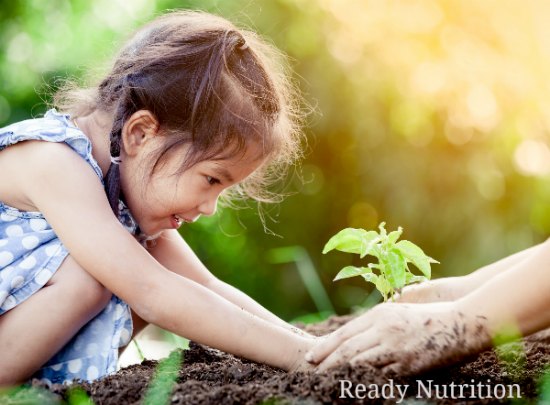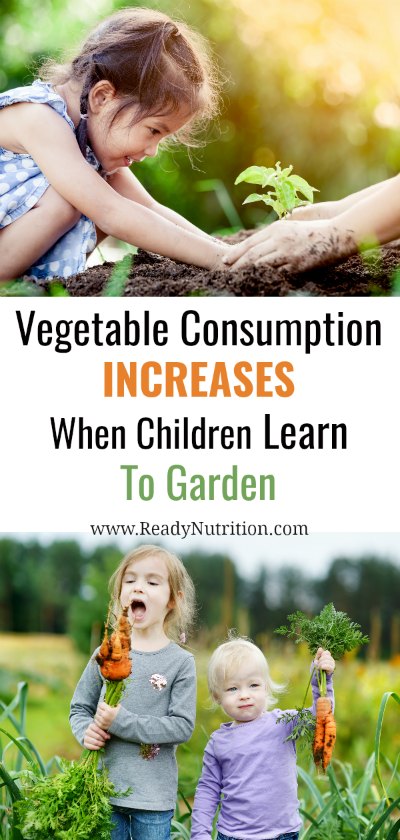
Any parent knows that children are often reluctant to eat their vegetables, especially considering the processed yet flavorful foods they are surrounded with anymore. But teaching them to grow food in a garden can help change this trend. They can’t grow a Cheeto!
In a study conducted by Parmer et al., second graders who participated in school gardening as part of a nutrition education class increased their selection and consumption of vegetables at school, compared to second graders who did not participate in gardening. In addition, students who gardened demonstrated a higher preference for the fruits and vegetables that they had sampled. This suggests that children want to actually try the foods they grow themselves leading them to make healthier choices even at a young age.
But that isn’t the only study that looked at the effects a vegetable garden can have on our children. In another study, which was conducted by Ratcliffe et al., middle schoolers with garden-based nutritional education demonstrated a higher preference for vegetables than the students who were not exposed to garden-based nutritional education. Students who gardened were also more willing to taste vegetables and increased the variety of vegetables they ate at school. Since most Middle schoolers have more freedom when it comes to making food choices than elementary school students, they often tend to eat fewer vegetables as they approach their adolescent years.
A garden for your school may serve as an effective way to increase vegetable consumption in young kids and maintain higher levels of vegetable consumption in adolescents. If you homeschool, it could be highly effective to garden at your home and teach your children about healthy food choices. Personally, I often allow my children to try to read the ingredient list on a bag of Cheetos (for example) just to see their reaction as they attempt to sound out the chemicals listed. Then a simple explanation as to why Cheetos are more of a “food-like” substance rather than a nutritional food goes a long way to nourish the body and mind.
“If it came from a plant, eat it. If it was made in a plant, don’t,” says the author of Food Rules: An Eater’s Manual, Michael Pollan. “It’s not food if it’s served through the window of your car. It’s not food if it’s called by the same name in every language. Think Big Mac, Cheetos or Pringles.”
Gardens can be used to teach many subjects and they do serve as a reminder to parents to reinforce health messages students receive in other activities at school and at home. If a garden is not possible for your family, consider alternative ideas, such as beginning a gardening project at your kids’ school which could include school family nights. You could also consider a community supported agriculture (CSA) programs. Many of these programs increase families’ access to fresh produce by offering shares families can purchase. Some even provide adults with ideas for preparing produce in ways most children can enjoy. Plus, these programs often give children and their parents a way to interact with the farmer who actually grew the food they will be eating. Since children are naturally inquisitive, the questions they ask the farmer could serve as very important gateways to eating right.
It is also important that the parents eat the food grown as well. Even if your child’s school has a garden, nutritional education shouldn’t stop when the child gets home. Making healthy choices for dinner at home can also have a positive impact on what your child chooses to eat for themselves. But this isn’t limited to school-aged children, meaning it is never too late to learn to garden!
College students who garden, or who learned to garden as children, eat more fruits and vegetables than their peers who do not or never learned to garden. The findings were based on a survey of 1,351 students conducted for the “Get Fruved” project, a collaboration between eight American universities aimed at improving the health and diet of students across the country. Anne Matthews, Ph.D., wanted to know how much gardening had affected the eating habits of college-aged kids. She and her team found that 30 percent (of the college-ages kids in the study) had gardened as a child, and 38 percent gardened at the time of the interview. Compared to students who said they never gardened, those “green-thumb” groups reported eating more fruits and vegetables: an average of 2.9 cups a day, versus just 2.4.
The bottom line is to help children understand gardening and how to grow their own food. Making it fun and getting children involved helps them understand where their food should come from. Gardening also serves to give kids a variety of vegetables to try in new ways and has shown to be successful in helping them make positive food choices as they age. Teaching them to grow their own food may also help in getting them interested in tasting new and different vegetables too. They may even want to help in preparation of the vegetables for dinner.
Try a garden, or work with your school to add one and watch your children learn how to eat better seemingly on their own!

This article was originally published at Ready Nutrition™ on June 16th, 2018






